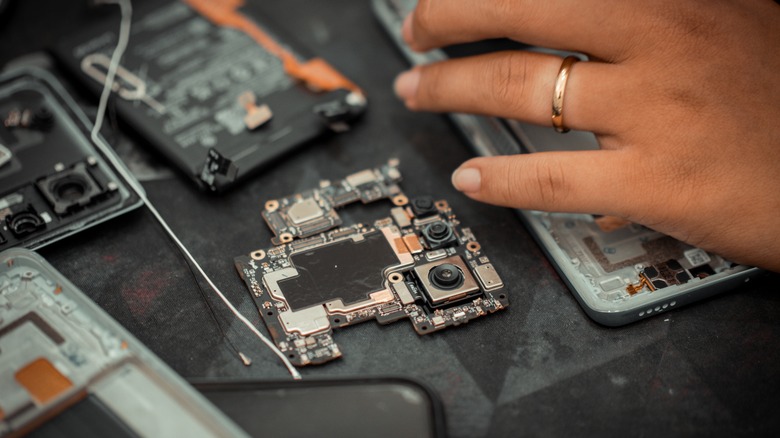Is Goo Gone Safe To Use On Electronics?
As electronics like smartphones and tablets have become more ubiquitous in our daily lives, so too has those devices' exposure to gross, sticky substances. Anyone who's ever dropped their phone into a bowl of ice cream knows getting all of that stuff off before the phone becomes a magnet for dust and hair will be borderline impossible. In such a dire circumstance, you may be tempted to resort to chemical-based options for cleaning off the gunk.
When it comes to removing goo, Goo Gone adhesive removers are an attractive option. Indeed, when it comes to dissolving unwanted adhesives and goopy substances, particularly on hard surfaces like the sides of your car, Goo Gone's solvent-based formula is quite proficient. As such, if you've got some gooey grossness somewhere on or in your electronic devices, it makes sense to try to spray on some Goo Gone. You might want to think twice about doing that, though, because while Goo Gone is fine to use on solid surfaces, it can do more harm than good on a device's delicate circuitry.
Goo Gone should not be directly applied to electronic components
The internal circuitry of just about any electronic device is extremely sensitive. There can't be any substances on there that aren't supposed to be present, or the flow of electricity and information could be thrown completely out of whack. The problem with using Goo Gone on or in the vicinity of these components is that, even if you manage to dissolve and remove the original offending substance, you could end up with a new, potentially worse problem caused by the Goo Gone itself.
Because Goo Gone's primary ingredient is a solvent, and a much more intense one than something like WD-40, it will dissolve just about anything it comes into contact with. Obviously, the various bits that make up your devices' internal components have been soldered or adhered in place, which means exposure to solvent could loosen them up and break them.
Even on some of the external components of a device, such as a smartphone's screen or casing, Goo Gone can cause problems. Spraying Goo Gone on a screen can cause etching and discoloration, while the leftover residue can make the screen less responsive to touch input.
Goo Gone can be carefully used on surfaces like cables and cartridges
While it's unwise to use Goo Gone directly on electronic devices themselves, the chemical can be used very sparingly on certain standalone surfaces. For example, if you've dropped something sticky on some sealed computer cables or need to peel a sticker off an old game cartridge, Goo Gone can make those particular jobs happen without causing damage.
However, if you intend to use Goo Gone in this fashion, you must do so with the utmost caution. Before applying Goo Gone directly to affected areas, you should first perform a spot test on an out-of-the-way area to ensure the surface won't be marked or damaged. Additionally, Goo Gone should be applied very sparingly with a secondary cleaning tool like a microfiber cloth or a cotton swab. Finally, particular care must be taken to ensure none of the Goo Gone makes any contact with any exposed electrical components. If you're concerned about causing damage, it may be better to stick with more tried-and-true methods of electronic cleaning, like isopropyl alcohol.


